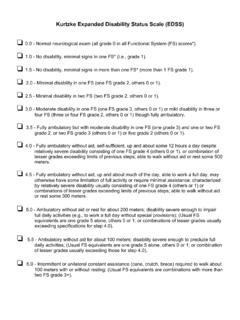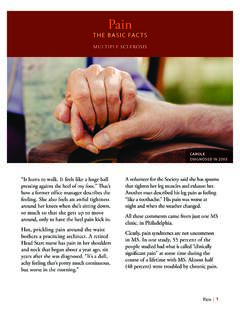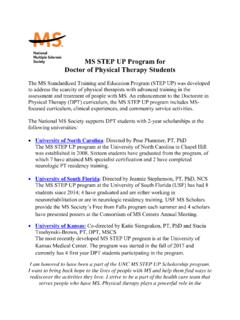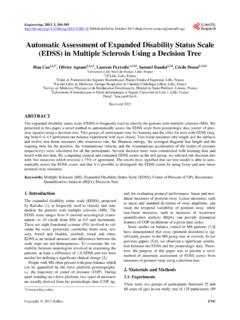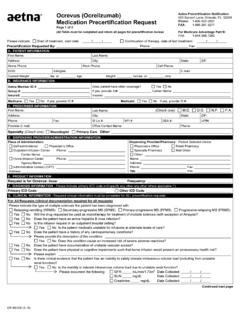Transcription of Kurtzke Functional Systems Scores (FSS)
1 Kurtzke Functional Systems Scores (FSS) Pyramidal Functions 0 - Normal 1 - Abnormal signs without disability 2 - Minimal disability 3 - Mild to moderate paraparesis or hemiparesis (detectable weakness but most function sustained for short periods, fatigue a problem); severe monoparesis (almost no function) 4 - Marked paraparesis or hemiparesis (function is difficult), moderate quadriparesis (function is decreased but can be sustained for short periods); or monoplegia 5 - Paraplegia, hemiplegia, or marked quadriparesis 6 - Quadriplegia 9 - (Unknown) Cerebellar Functions 0 - Normal 1 - Abnormal signs without disability 2 - Mild ataxia (tremor or clumsy movements easily seen, minor interference with function) 3 - Moderate truncal or limb ataxia (tremor or clumsy movements interfere with function in all shpheres) 4 - Severe ataxia in all limbs (most function is very difficult) 5 - Unable to perform coordinated movements due to ataxia 9 - (Unknown) Record #1 in small box when weakness (grade 3 or worse on pyramidal) interferes with testing.
2 Brainstem Functions 0 - Normal 1 - Signs only 2 - Moderate nystagmus or other mild disability 3 - Severe nystagmus, marked extraocular weakness, or moderate disability of other cranial nerves 4 - Marked dysarthria or other marked disability 5 - Inability to swallow or speak 9 - (Unknown) Sensory Function 0 - Normal 1 - Vibration or figure-writing decrease only in one or two limbs 2 - Mild decrease in touch or pain or position sense, and/or moderate decrease in vibration in one or two limbs; or vibratory (c/s figure writing) decrease alone in three or four limbs 3 - Moderate decrease in touch or pain or position sense, and/or essentially lost vibration in one or two limbs; or mild decrease in touch or pain and/or moderate decrease in all proprioceptive tests in three or four limbs 4 - Marked decrease in touch or pain or loss of proprioception, alone or combined, in one or two limbs; or moderate decrease in touch or pain and/or severe proprioceptive decrease in more than two limbs 5 - Loss (essentially) of sensation in one or two limbs.
3 Or moderate decrease in touch or pain and/or loss of proprioception for most of the body below the head 6 - Sensation essentially lost below the head 9 - (Unknown) Bowel and Bladder Function (Rate on the basis of the worse function, either bowel or bladder) 0 - Normal 1 - Mild urinary hesitance, urgency, or retention 2 - Moderate hesitance, urgency, retention of bowel or bladder, or rare urinary incontinence (intermittent self-catheterization, manual compression to evacuate bladder, or finger evacuation of stool) 3 - Frequent urinary incontinence 4 - In need of almost constant catheterization (and constant use of measures to evacuate stool) 5 - Loss of bladder function 6 - Loss of bowel and bladder function 9 - (Unknown) Visual Function 0 - Normal 1 - Scotoma with visual acuity (corrected) better than 20/30 2 - Worse eye with scotoma with maximal visual acuity (corrected) of 20/30 20/59 3 - Worse eye with large scotoma, or moderate decrease in fields, but with maximal visual acuity (corrected) of 20/60 20/99 4 - Worse eye with marked decrease of fields and maximal visual acuity (corrected) of 20/100 20/200; grade 3 plus maximal acuity of better eye of 20/60 or less 5 - Worse eye with maximal visual acuity (corrected) less than 20/200.
4 Grade 4 plus maximal acuity of better eye of 20/60 or less 6 - Grade 5 plus maximal visual acuity of better eye of 20/60 or less 9 - (Unknown) Record #1 in small box for presence of temporal pallor Cerebral (or Mental) Functions 0 - Normal 1 - Mood alteration only (does not affect EDSS score ) 2 - Mild decrease in mentation 3 - Moderate decrease in mentation 4 - Marked decrease in mentation (chronic brain syndrome moderate) 5 - Dementia or chronic brain syndrome severe or incompetent 9 - (Unknown) Sources: Kurtzke JF. Rating neurologic impairment in multiple sclerosis: an expanded disability status scale (EDSS). Neurology. 1983 Nov;33(11):1444-52. Haber A, LaRocca NG. eds. Minimal Record of disability for multiple sclerosis. New York: National Multiple Sclerosis Society; 1985.
5
